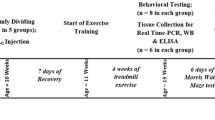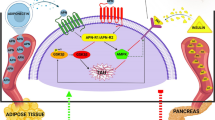Abstract
Objectives
To determine the effects of treadmill exercise training and rutin intervention independently and in combination on key molecules involved in Alzheimer’s disease (AD) pathology and cognitive function in diet induced obese (DIO) mice.
Methods
C57BL/6J mice were randomized into 5 groups: chow group, high fat diet group (HFD), HFD plus rutin intervention group (HR), HFD combined with treadmill running group (HE), HFD combined with treadmill running and rutin group (HRE). At the end of the intervention, Morris water maze test was conducted to assess hippocampal dependent, long term spatial learning and memory retention. Hippocampus and cortex were dissected and the protein expression of key molecules including insulin-degrading enzyme (IDE), Beta-secretase (BACE1), signal transducer and activator of transcription 3 (STAT3), cAMP-response element binding protein (CREB), post-synaptic density protein 95 (PSD-95) and synaptophysin were measured via western blotting.
Results
Exercise and rutin enhances HFD induced cognitive deficits in DIO mice. In the hippocampus, although HFD has no effect on IDE, BACE1, phosphorylation (p)-STAT3 and p-CREB, HR and HE group have elevated protein expression of IDE; meanwhile, p-CREB was elevated in the HE and HRE group. In the cortex, HFD led to induction in BACE1 and reduction in p-STAT3 and PSD95. Rutin or exercise reversed BACE1, p-STAT3 and PSD95 to normal levels.
Conclusions
Treadmill running and rutin could improve HFD induced cognitive impairment, and p-STAT3, p-CREB, BACE1, IDE, and PSD95 are potential mediators involved in the protective effects of rutin or exercise against HFD induced cognitive dysfunction.





Similar content being viewed by others
References
Alkam T, Nitta A, Mizoguchi H, et al. A natural scavenger of peroxynitrites, rosmarinic acid, protects against impairment of memory induced by Abeta(25-35). Behav Brain Res 2007;180 (2):139–145
Reddy PH. Amyloid precursor protein-mediated free radicals and oxidative damage: implications for the development and progression of Alzheimer’s disease. J Neurochem 2006;96 (1):1–13
Kang EB, Kwon IS, Koo JH, et al. Treadmill exercise represses neuronal cell death and inflammation during Abeta-induced ER stress by regulating unfolded protein response in aged presenilin 2 mutant mice. Apoptosis 2013;18 (11):1332–1347
Maesako M, Uemura K, Kubota M, et al. Exercise is more effective than diet control in preventing high fat diet-induced beta-amyloid deposition and memory deficit in amyloid precursor protein transgenic mice. J Biol Chem 2012;287 (27):23024–23033
Speisman RB, Kumar A, Rani A, et al. Daily exercise improves memory, stimulates hippocampal neurogenesis and modulates immune and neuroimmune cytokines in aging rats. Brain Behav Immun 2013;28:25–43
Hosseinzadeh H, Nassiri-Asl M. Review of the protective effects of rutin on the metabolic function as an important dietary flavonoid. J Endocrinol Invest 2014;37 (9):783–788
Javed H, Khan MM, Ahmad A, et al. Rutin prevents cognitive impairments by ameliorating oxidative stress and neuroinflammation in rat model of sporadic dementia of Alzheimer type. Neuroscience 2012;210:340–352
Moghbelinejad S, Nassiri-Asl M, Farivar TN, et al. Rutin activates the MAPK pathway and BDNF gene expression on beta-amyloid induced neurotoxicity in rats. Toxicol Lett 2014;224 (1):108–113
Luchsinger JA, Gustafson DR. Adiposity and Alzheimer’s disease. Curr Opin Clin Nutr Metab Care 2009;12 (1):15–21
Profenno LA, Porsteinsson AP, Faraone SV. Meta-analysis of Alzheimer’s disease risk with obesity, diabetes, and related disorders. Biol Psychiatry 2010;67 (6):505–512
Whitmer RA, Gustafson DR, Barrett-Connor E, et al. Central obesity and increased risk of dementia more than three decades later. Neurology 2008;71 (14):1057–1064
Morris MC, Tangney CC. Dietary fat composition and dementia risk. Neurobiol Aging 2014;35 Suppl 2:S59–64
Herrup K. Reimagining Alzheimer’s disease—an age-based hypothesis. J Neurosci 2010;30 (50):16755–16762
McAllister C, Long J, Bowers A, et al. Genetic targeting aromatase in male amyloid precursor protein transgenic mice down-regulates beta-secretase (BACE1) and prevents Alzheimer-like pathology and cognitive impairment. J Neurosci 2010;30 (21):7326–7334
Miners JS, Baig S, Palmer J, et al. Abeta-degrading enzymes in Alzheimer’s disease. Brain Pathol 2008;18 (2):240–252
Chiba T, Mack L, Delis N, et al. Stat3 inhibition in neural lineage cells. Horm Mol Biol Clin Investig 2012;10 (2):255–263
Lee YS, Silva AJ. The molecular and cellular biology of enhanced cognition. Nat Rev Neurosci 2009;10 (2):126–140
Bhat NR, Thirumangalakudi L. Increased tau phosphorylation and impaired brain insulin/IGF signaling in mice fed a high fat/high cholesterol diet. J Alzheimers Dis 2013;36 (4):781–789
Gao M, Ma Y, Liu D. Rutin suppresses palmitic acids-triggered inflammation in macrophages and blocks high fat diet-induced obesity and fatty liver in mice. Pharm Res 2013;30 (11):2940–2950
Jun JK, Lee WL, Park HG, et al. Moderate intensity exercise inhibits macrophage infiltration and attenuates adipocyte inflammation in ovariectomized rats. J Exerc Nutrition Biochem 2014;18 (1):119–127
Sakurai T, Ogasawara J, Kizaki T, et al. The effects of exercise training on obesity-induced dysregulated expression of adipokines in white adipose tissue. Int J Endocrinol 2013:801743
Morris RG. Toward a representational hypothesis of the role of hippocampal synaptic plasticity in spatial and other forms of learning. Cold Spring Harb Symp Quant Biol 1990;55:161–173
Wan Z, Thrush AB, Legare M, et al. Epinephrine-mediated regulation of PDK4 mRNA in rat adipose tissue. Am J Physiol Cell Physiol 2010;299 (5):C1162–1170
Chen N, Zhou L, Zhang Z, et al. Resistin induces lipolysis and suppresses adiponectin secretion in cultured human visceral adipose tissue. Regul Pept 2014;194–195:49–54
Obrosova IG, Ilnytska O, Lyzogubov VV, et al. High-fat diet induced neuropathy of pre-diabetes and obesity: effects of «healthy» diet and aldose reductase inhibition. Diabetes 2007;56 (10):2598–2608
Hoveida R, Alaei H, Oryan S, et al. Treadmill running improves spatial memory in an animal model of Alzheimer’s disease. Behav Brain Res 2011;216 (1):270–274
Reisi P, Alaei H, Babri S, et al. Effects of treadmill running on spatial learning and memory in streptozotocin-induced diabetic rats. Neurosci Lett 2009;455 (2):79–83
Chiba T, Yamada M, Sasabe J, et al. Amyloid-beta causes memory impairment by disturbing the JAK2/STAT3 axis in hippocampal neurons. Mol Psychiatry 2009;14 (2):206–222
Dickson DW, Crystal HA, Bevona C, et al. Correlations of synaptic and pathological markers with cognition of the elderly. Neurobiol Aging 1995;16 (3):285–298; discussion 298-304
Han K, Kim E. Synaptic adhesion molecules and PSD-95. Prog Neurobiol 2008;84 (3):263–283
Gylys KH, Fein JA, Yang F, et al. Synaptic changes in Alzheimer’s disease: increased amyloid-beta and gliosis in surviving terminals is accompanied by decreased PSD-95 fluorescence. Am J Pathol 2004;165 (5):1809–1817
Nyffeler M, Zhang WN, Feldon J, et al. Differential expression of PSD proteins in age-related spatial learning impairments. Neurobiol Aging 2007;28 (1):143–155
Murray AJ, Knight NS, Cochlin LE, et al. Deterioration of physical performance and cognitive function in rats with short-term high-fat feeding. FASEB J 2009;23 (12):4353–4360
Edwards LM, Murray AJ, Holloway CJ, et al. Short-term consumption of a high-fat diet impairs whole-body efficiency and cognitive function in sedentary men. FASEB J 2011;25 (3):1088–1096
Author information
Authors and Affiliations
Corresponding author
Rights and permissions
About this article
Cite this article
Cheng, J., Chen, L., Han, S. et al. Treadmill running and rutin reverse high fat diet induced cognitive impairment in diet induced obese mice. J Nutr Health Aging 20, 503–508 (2016). https://doi.org/10.1007/s12603-015-0616-7
Received:
Accepted:
Published:
Issue Date:
DOI: https://doi.org/10.1007/s12603-015-0616-7




